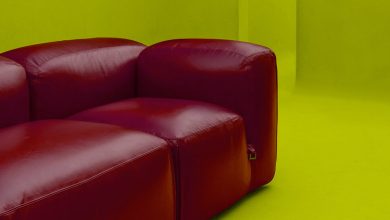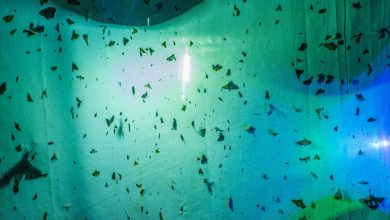In All That He Does, Gaetano Pesce Looks to Counteract Sameness

More than 60 years into the architect and artist Gaetano Pesce’s career, his doughy-looking, gelatinous furniture is held up as a rebuttal to the uniformity of minimalist design: a modular sofa resembling a city skyline at dusk; a jewel-tone resin cabinet in the shape of a man on all fours; a biomorphic, womblike red armchair tethered to a spherical ottoman — a comment on female subjugation and, he says, “better than Brancusi.” In 2020, when Pesce’s New York gallery, Salon 94, approached the Aspen Art Museum about mounting an exhibition of his objects in the institution’s four-story space, designed by Shigeru Ban and covered on two sides with a severe woven-wood grid, the 82-year-old recalls having said, “I won’t do it in a prison.” As a workaround, Pesce proposed “My Dear Mountains,” a site-specific installation comprising LEDs and 3-D inflatable volumes that would temporarily obscure the building’s facade with the image of a sun setting behind a mountain range on a starry night. “For some reason, they enjoyed the idea,” Pesce explains from his colorful, cluttered studio in the Brooklyn Navy Yard as he examines some sierra-shaped resin vases, which will go on sale in an edition of 25 when the show opens on May 25.
This architectural project seems to have reinvigorated another one that he’s been dreaming about for 35 years. To counteract what he derides as “suppository” structures — Jean Nouvel’s Agbar Tower in Barcelona, Norman Foster’s so-called Gherkin in London and Renzo Piano’s Weltstadthaus department store in Cologne — Pesce hopes to one day break ground on a building in New York City in which each floor is designed by a different architect. “It’s a view of democracy where you have all kinds of expression, languages, realities,” he says. “The politicians will tell you we’re all the same. They are stupid. We are fortunately not all the same, and architecture can represent that.” As his assistants toil nearby, Pesce discusses, among other things, why that which separates us keeps us together.
How did it happen that you took over the facade of the Aspen Art Museum?
Well, they’d agreed to do a show. I was interested, but then I saw the museum.
The building itself, you mean?
Yes. A museum is about enriching the soul. It’s about the value of art and freedom. But that building is a prison. There’s no connection between Aspen, which has a very strong identity, and the architecture. Maybe I’m exaggerating, but it suggests a totalitarian view of the world. To me, the International Style of architecture reflects a political ideology of sameness — that we must all think the same way or dress the same way. I believe that the treasure of the world is diversity. To have one single ideology is a disaster. If we are the same, we cannot talk, because there is nothing to say. But if you and I are different, there’s a lot to exchange. If I was going to do something in Aspen, I wanted to take into consideration that the city has its own identity, something that makes it different from anywhere else. And when I saw the museum, I said, “I must do a project that’s the exact opposite of this, even at the risk of creating kitsch.”
Why make it inflatable?
The plan was to create a rigid form, but it blocked the sidewalk and people couldn’t pass. I liked the idea of making something ephemeral. I always work in a multidisciplinary way, because I believe that art and expression have no barriers. One day, you have an idea for a poem; the next, you have an idea for a song. The best artists are also physicians, mathematicians and musicians. That’s how I like to work. And what’s characteristic of my style is that I’m totally against the idea of minimalism. If I look around Manhattan, all the buildings express the same thing. They’re all towers. The only guy who was a little radical was Frank Lloyd Wright when he made the Guggenheim. The rest are all just repetitions of a flaw.
What is your relationship to Aspen?
I went there the first time I came to America. They used to have a very famous design conference. I was invited by IBM to give a lecture when I was, like, 35 years old. Famous people like Eliot Noyes and Buckminster Fuller were there. I started going every year — until one night I got a kind of pneumonia at a restaurant. It was a horrible experience. The pneumonia went away shortly after I got back to Europe, so I said, “Look, it’s better for me not to go to Aspen anymore.” And yet, I love it there. I like the coyotes at night. I like looking out at the very tops of the mountains.
Do you ski?
Never in my life.
You’ve said that your work is inherently political. But is it also intended to be fun?
Yes, that is very important. My visual language is meant to create pleasure. And it’s always a response to what’s happening in the world. If there’s a war, I must do something, if possible, to make people laugh or smile. The only other option is too depressing. In that way, the work has an important function. When you add not just good use of material to an object but a point of view, whether it’s political or social or religious, then it becomes art.
When you look at your body of work, do you see a history of political action?
In certain things, yes. In others, I’m expressing only my curiosity about a new technology.
What else inspires you?
I find inspiration through observing diversity.
Is the curse of the designer that you’re always thinking about how you could have made someone else’s object better?
Yes, that happens without me wanting it to.
Who do you think is making interesting buildings?
Maybe Jean Nouvel, I don’t know. The tower that he made in Barcelona that looks like a suppository is very funny. He copied the English guy, what’s his name?
Norman Foster.
I gave a lecture at the Royal Academy of Art in London, where I said to the audience, “Can you explain to me the relationship between your English identity and that suppository?” The room went silent. But it’s true! Why did they build a suppository? Renzo Piano also made one in Stuttgart. It’s a thing.
Are you optimistic about the new generation of designers and architects?
Yes, but I’m not optimistic about their teachers. They teach what they were taught when they were young, so their wisdom is already old. That’s a problem.
How long will your piece cover the museum’s facade?
I have no idea. It would be fantastic if they decided to keep it there forever.
This interview has been edited and condensed.



